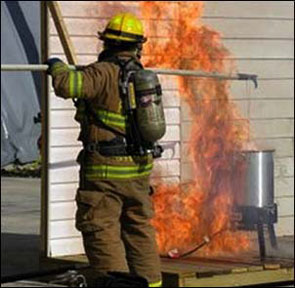 Commentary by: Lt. Col. Jamey Creek, Base Operations Manager TCGC and Buffalo Gap Firefighter
Commentary by: Lt. Col. Jamey Creek, Base Operations Manager TCGC and Buffalo Gap Firefighter
Photo by: courtesy of All Hands Fire Equipment
You will likely be utilizing propane, a burner and extremely hot oil to cook your turkey. The safe operation and application of these essentials are vital to success of your Thanksgiving Meal.
Last year was my first attempt at frying a turkey. I simply searched the internet, watched numerous videos and read several articles on frying a turkey. Most all are similar in nature, with only slight variables in temperature, time and seasoning. A good link to review is: http://www.heb.com/page/recipes-cooking/cooking-tips/deep-fried-turkey
However, good old fashion first-hand experience is hard to beat. The following are personal lessons learned along with my experience as a volunteer firefighter.
- Make certain safety items are in close proximity. A fire extinguisher is an incredibly handy tool when needed. Even more important is to have a phone and the number for your local Emergency Service Provider. Most likely, the simple 9-1-1 will do the trick. Do not wait if an event occurs. Time is critical on fires. The faster responders get there, the greater the likelihood of success will be.
- Make sure you are familiar with the operation of your propane burner. There are several variables; most notable is that some burners are equipped with timers that require your frequent attendance. Otherwise, it will automatically shut off after a few minutes.
- Firmly seat the hose from your burner to the propane tank. A faulty connection can be disastrous. Simply turn on the propane valve and listen for a “hissing” noise to confirm or deny your connection. If you hear or smell anything, immediately close the valve and re-check your connection.
- Proper oil depth is imperative. Too little oil prevents proper cooking and too much oil can lead to a fire and or injuries. The best method is to place your turkey into your pot and cover with water. You must then remove the turkey and mark the depth. This will later become the fill mark for your oil. The pot must subsequently be dried along with the turkey.
- Under no circumstance should you make an adjustment to the fryer pot without first turning off the burner. This is the most abused step, which leads to the most injuries when frying. By turning off the burner, there are no flames to ignite a potential oil spill. If oil is spilled, be sure to wipe it up prior to relighting the burner.
- Flip-flops, short shorts and short sleeves are not your friend when contact is made with 325-375 degree oil. Dress for success when frying. Leather shoes, long pants, long sleeves and gloves are imperative for your protection.
- The turkey MUST BE fully thawed and as dry as possible before placing into the hot oil. A significant emotional event will instantly occur if a frozen turkey is dropped into 375 degree oil. Your local emergency service providers will most certainly be needed if this is done.
- Location is important. Your frying location should be on a hard, level and non- combustible surface. It must also be out of the wind, but in a well-vented area.
A simple review of these lessons learned, combined with quality research time will undoubtedly set the stage for your safe and enjoyable holiday meal.
Happy Thanksgiving!